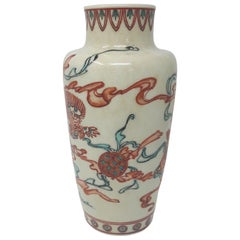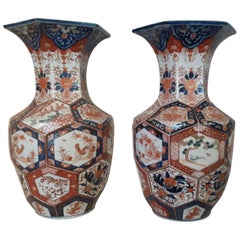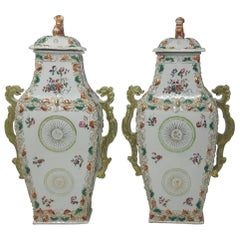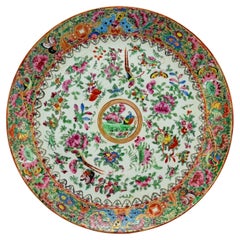Mahs Antiques Ceramics
to
3
3
1
1
1
1
3
3
3
3
2
1
3
3
3
1
Unusual Early 20th Century Makuzu Kozan Vase
By Makuzu Kozan
Located in London, GB
Decorated in iron-red and green enamels with an overall design of three shish frolicking with a brocade ball, signed on the base with an impressed seal Makuzu.
The storage box ti...
Category
Early 20th Century Japanese Meiji Ceramics
Materials
Porcelain
Pair of 19th Century Imari Vases
By Japanese Studio
Located in London, GB
A fine pair of Meigi period with painted panels of birds and flowers on a pentagon background.
...
Category
Antique 1890s Japanese Meiji Ceramics
Materials
Porcelain
$3,406 / item
18th Century Chinese Export Famille Rose Vases, circa 1750
Located in London, GB
A pair of 18th century famille rose vases painted and applied decoration of squirrels flowers and leaves.
Category
Antique 18th Century Chinese Chinese Export Ceramics
Materials
Porcelain
Related Items
Large Chinese Export Famille Rose Medallion Porcelain Charger, Mid-19th Century
Located in Atlanta, GA
A richly enameled Chinese Export porcelain charger in the classic Famille Rose Medallion palette, dating to the mid-19th century, Qing Dynasty, circa 1850. This large dish exemplifie...
Category
Antique Mid-19th Century Chinese Chinese Export Ceramics
Materials
Porcelain
$950
H 0.5 in Dm 13 in
Large 19th Century Japanese Imari Ware Porcelain Vase
Located in Bradenton, FL
A large scale and very good quality late 19th century Japanese Imari vase with exotic birds, trees and flowers. Wonderful coloring in vibrant hues of blue, red and rust.
Category
Antique 19th Century Japanese Japonisme Ceramics
Materials
Porcelain
A Japanese Imari Plate, 19th Century
Located in ARMADALE, VIC
A Japanese Imari Plate, 19th Century
Home decor, Interior design and collectibles.
Provenance: Private Australian Collection.
Dimension: Height: 4.5cm Diameter: 30cm
Category
Antique 19th Century Japanese Ceramics
Materials
Porcelain
Chinese Export Famille Rose Pheasant With Ormolu Mounts, Late 19th Century
Located in Austin, TX
A gorgeous Chinese export famille rose enameled porcelain model of a pheasant mounted on an ormolu stand.
The elegant bird is portrayed perched on a ...
Category
Antique Late 19th Century Chinese Chinese Export Animal Sculptures
Materials
Ormolu
$12,500
H 9.75 in W 6 in D 7 in
Chinese Export Famille Rose Porcelain Plate
Located in Astoria, NY
Chinese Export Famille Rose Porcelain Plate, with hand-painted central landscape scene with a peacock and flowers encircled by a scrolling floral border. 9" Diameter x 1.25" H. P...
Category
Antique Late 19th Century Chinese Qing Ceramics
Materials
Porcelain
Chinese Export Porcelain Plate Famille Rose Hand Painted Figures, Circa 1940s
Located in Lincoln, Lincolnshire
This is a good Chinese Export porcelain Plate which has been beautifully hand enamelled, over-glaze, in the Famille Rose palette with excellent detail, dating to Circa 1940.
The mai...
Category
Mid-20th Century Chinese Chinese Export Ceramics
Materials
Porcelain
$237
H 1.15 in Dm 9.94 in
Pair of Rare Porcelain Commemorative Vases by Makuzu Kozan Meiji Period
By Makuzu Kozan
Located in Atlanta, GA
A pair of porcelain vases in classic form, decorated with underglaze blue and copper red painting by Imperial potter Makuzu Kozan. Also known as Miyagawa Kozan (1842–1916), Makuzu was one of the most established and collected ceramist known to the west from Meiji Period.
The vases are in a classic Chinese form called "Bang Chu Ping" (grain-mallet vase...
Category
Vintage 1910s Japanese Japonisme Ceramics
Materials
Ceramic
A Japanese Imari Vase, 19th Century
Located in ARMADALE, VIC
A Japanese Imari Vase, 19th Century
Provenance: Private Australian Collection.
Description:
The body embellished with a repeating design of flowers and dragon cartouches united by ...
Category
Antique 19th Century Japanese Ceramics
Materials
Porcelain
Japanese Glazed Ceramic and Silver Koro Incense Burner Makuzu Kozan
By Makuzu Kozan
Located in Atlanta, GA
A tri-pod ceramic incense burner (koro) by Japanese Imperial potter Makuzu Kozan (1842-1916) circa late Meiji to the start of Taisho period (1890-1910s). A fine example of the artist's work belonging to the late part of his underglaze paint phase (started around 1887 until his death), the surface of the koro was painted in beautiful shades of blue to depict a continuous landscape not unlike a traditional ink and watercolor hand scroll. The rise and fall mountains recede and fade into the horizon and are dotted with groves of pines. The sky is painted with a beautiful subtle shade of pink, suggesting a time of sunrise or sunset. The koro is fitted with an ensuite reticulated sterling silver hoya (incense cover), pierced with swirling cloud and marked with "pure silver' in Kanji. The base is signed in underglaze blue "Makuzu Kozan Sei" within a double ring. The piece is beautifully potted in form and the decoration was done with expertise using the novel technique developed by Kozan called Fuki-e (the blow painting), in order to achieve the striking landscape known as "Mountain and Water" with sense of dimensions and gradient, the poetic effects normally conveyed only by sumi ink staining on paper. The piece comes with an unsigned tomobako (wood storage box) of a recent age.
Also known as Miyagawa Kozan (1842–1916), Makuzu Kozan was one of the most established and collected ceramist from Meiji Period. Born as Miyagawa Toranosuke, Kozan established his pottery studio in Yokohama around 1870s and later became one of the appointed artists to the Japanese Imperial household. His work was exhibited in many international fairs that the Meiji government participated at the turn of the century and won many grand prizes. Being one of the most creative ceramists, Kozan started experimenting with new chemical colors from the West in the format of his porcelain glaze around 1880s. New colors allowed him to create underglaze designs that appeared bright, smooth and glossy. He even invented his own receipt of cobalt blue to achieve a much brighter yet softer shade, as evident on this vase. To create landscape that is realistic and dimensional, more common in the western paintings, he was inspired by the native Japanese ink painting technique developed around 1900 by Yokoyama...
Category
Antique Early 1900s Japanese Japonisme Ceramics
Materials
Silver
Japanese Satsuma Ginger Jar Vase, circa Early 20th Century
Located in New York, NY
A beautiful small Japanese Satsuma ginger jar vase, circa early-20th century, Japan. Colors include cream, copper, green, blue, white, black, orange...
Category
Early 20th Century Japanese Meiji Vases
Materials
Ceramic, Earthenware, Pottery
19th Century Pair of Imari Porcelaine Lamp Mounted Gilt Bronze
By Imari Porcelain
Located in Marseille, FR
19th century pair of porcelain lamp from Imari. Frame gilt bronze decorations of metal polychrome flowers.
Category
Antique 19th Century Chinese Chinese Export Ceramics
Materials
Porcelain
Pair of Chinese Export Famille Rose Vases, Late 19th Century
Located in Atlanta, GA
This richly decorated pair of porcelain vases exemplifies the ornate style of Chinese export wares from the late Qing dynasty, likely produced in the final quarter of the 19th centur...
Category
Antique 19th Century Chinese Chinese Export Ceramics
Materials
Porcelain




